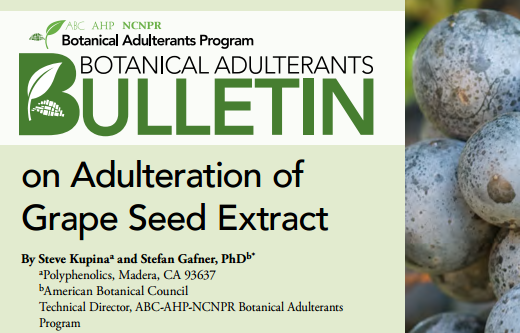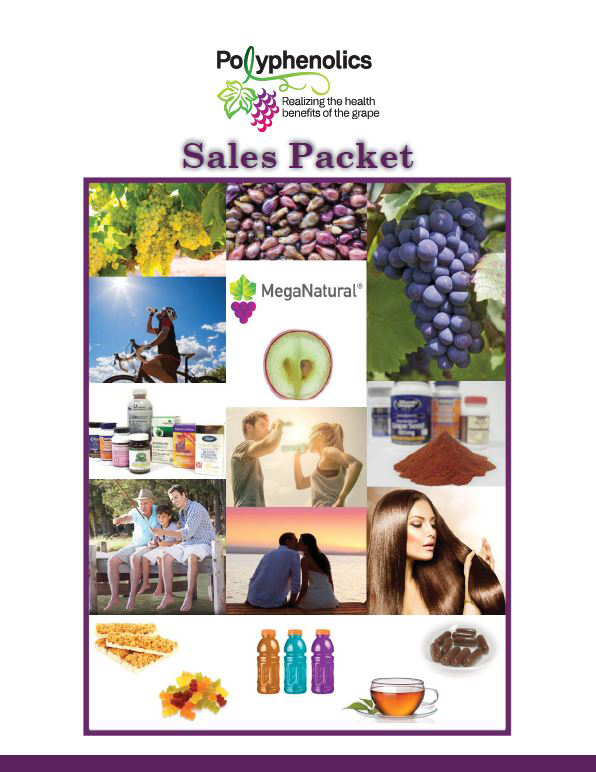Are there peanut skins in your grape seed extract?
Polyphenolics’ findings of adulterants in grape seed extracts points to need for best-in-class authentication practices
Polyphenolics’ chemists weren’t actively looking for adulterants in competitors’ finished grape seed extracts. But finding them reinforces the industry’s need for due diligence when sourcing raw ingredients. “Compromised quality can affect efficacy and erode customer trust,” said Mark Kelm, Ph.D. “This is why it’s so essential to us and our customers that, in addition to our farm-to-finish traceability, MegaNatural products are also tested for purity.”
Clever and sophisticated adulteration found in some grape seed extracts
Kelm says that he was comparing competitors’ grape seed extracts with Polyphenolics’ MegaNatural grape seed extracts. “We know that ours is authentic and pure because the raw materials are sourced from our parent company’s wineries and produced on site. We started noticing anomalies in competitors’ grape seed extracts that were strikingly different. We weren’t looking for adulterants, but we started seeing things that should not be in grape seed extracts; specifically compounds not found in grape seed.”
Further investigation revealed that a significant level of adulteration is occurring in our industry. Kelm explains that the adulterants belonged to the same class of phenolic compounds (i.e. proanthocyanidins) as pure grape seed extract, but were of a different subunit composition or type. Grape seed contains procyanidins which are composed of only (epi) catechin subunits. Whereas, in several competitor samples, (epi) afzelechin subunits were observed. These are referred to as “mixed” propelargonidin-procyanidin and do not occur in authentic grape extracts.
Kelm added, “We were also seeing doubly linked A-type procyanidins likely from peanut skins vs. singly linked procyanidins which are in grape seed extracts.” Peanut skins are a common waste stream wherever peanuts are processed or used, and are considered a cheap source of proanthocyanidins1. Kelm presented his research at the American Chemical Society National Meeting and Exposition in Boston in August, 2015. These findings are also included in a Botanical Adulterants Program (BAP) Bulletin on Adulteration of Grape Seed Extract, co-authored by Stefan Gafner, PhD, chief scientific officer at the American Botanical Council and Polyphenolics Director of Quality and Technology Steve Kupina.2
Kupina indicated, “Peanut skin extract is far less expensive and is produced in large volumes by the peanut industry, thus making it much more available than grape seed extract. It is also similar in chemical composition. One must conclude that the adulteration we are seeing is purposefully and strategically done for economic gain. The greatest and most immediate area of concern resulting from our research is the potential risk of allergic reaction, especially in extracts containing peanut-related adulterants.”
“While we have no way to definitively know where the adulterants are coming from,” Kelm stated, “this points to the need to test ingredients once they are received by the manufacturer. Protecting the safety and quality of supply chains is important.”
This means going beyond common methodologies. “What we found is a rather sophisticated form of adulteration. To adulterate with very similar compounds is quite shrewd. If you’re not familiar with grape seed extract chemistry, it would be easy to miss. The most widely used colorimetric assays are not selective. They would not distinguish between adulterated and unadulterated samples.”
No place to hide
Kelm called on his years of phenolic chemistry experience to pick things out of a chromatographic profile that shouldn’t be there and characterized their structures using mass spectrometry. “There are best-in-class tests that can be done. If you know what to look for, there’s no place to hide.”
He stresses that those conducting the assays need to know their product, have a working knowledge of proanthocyanidin chemistry, and have good familiarity with high-end instrumentation and how to interpret the data. “Anyone skilled in this art can do this.”
Authentication approaches include:
- Total phenolics measurement (Folin Ciocalteu or FC method): “This will give you a percent total phenolics which should match a vendor’s specs. This is a generic non-specific assay in the sense that it cannot differentiate between different classes of polyphenolics.”
- HPLC methods for screening against authentic samples: Hydrophilic interaction liquid chromatographic (HILIC) allows for separation based on degree of proanthocyanidin polymerization.3
- LC-MS and LC-MS/MS experiments for characterization of suspect samples
Confirming transparency
Grape seed extract is a hot commodity. While many finished product manufacturers stress transparency, Kelm cautions that they don’t know what they don’t know. “But I also believe that they are willing to do the extra work necessary to ensure the public is getting what they believe they are getting.”
The American Botanical Council (ABC), the American Herbal Pharmacopoeia (AHP) and the University of Mississippi’s National Center for Natural Products Research (NCNPR) have initiated a large-scale program to educate members of the herbal and dietary supplement industry about ingredient and product adulteration. Polyphenolics is one of several supporters of the ABC-AHP-NCNPR Botanical Adulterants Program in its effort to help protect consumers.
Kelm concludes, “Due diligence in this area is critical to confirming that your products are authentic and of the highest quality.”
Biography: Mark Kelm
Mark Kelm, Ph.D. He joined the company in 2006 as Senior Research Chemist. Dr. Kelm is experienced in the areas of natural products chemistry, extraction, purification, separation science, structural characterization and elucidation. He holds publications and patents in these areas. He is also skilled in analytical chemistry, as well as agricultural waste stream utilization for a generation of value-added products, including grape seed/skin extracts, and their application. Dr. Kelm is currently leading research at the bench and pilot scale with a diverse team of scientists.
Biography: Steve Kupina
Steve Kupina, M.S. Senior Manager of Technical Sales, Polyphenolics, a division of California Natural Color and E. & J. Gallo Winery. Graduated with a M.S. in Chemistry from California State University, Fresno. Steve was initially responsible for developing key analytical technologies for both Research & Development and Polyphenolics. Steve has represented Polyphenolics in the Wine Institute, AOAC, Technical Committee on Juice and Juice Products (TCJJP) and American Society of Enology and Viticulture. He has seven publications and a patent on state-of-the-art analytical methodologies for grape juice and wine.
1Zhao, X., Chen, J., & Du, F. (2012). Potential use of peanut by-products in food processing: A review. Journal of Food Science and Technology. 49(5):521-529.
2Botanical Adulterants Program Bulletin on Adulteration of Grape Seed Extract. American Botanical Council website. http://cms.herbalgram.org/BAP/BAB/GrapeSeedExtractBulletin.html.
3Kelm, M. A., Versari, A., Parpinello, G. P., & Thorngate, J. H. (2012). Mass Spectral Characterization of Uva Longanesi Seed and Skin Extracts. Journal of Enology and Viticulture. 63:402-406.




